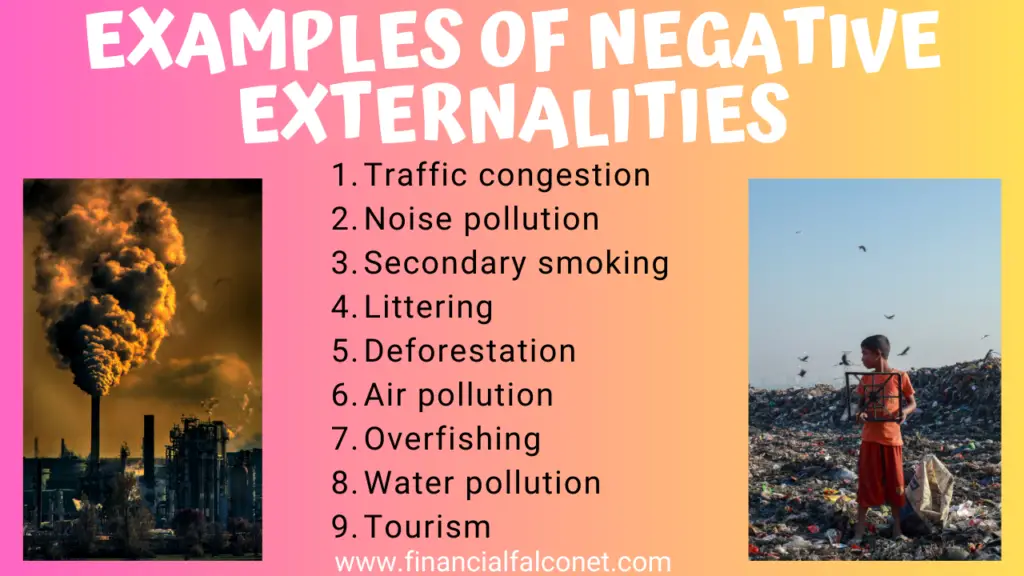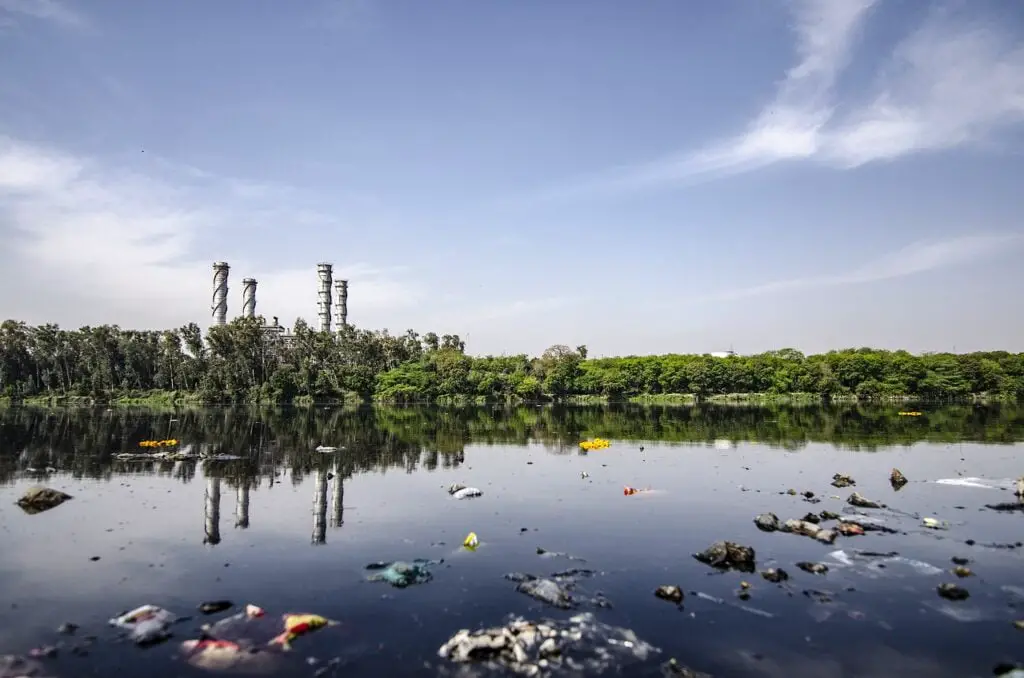Examples of negative externalities in economics include traffic congestion, environmental pollution, the negative impacts of tourism, secondary smoking, etc. These are usually the negative impacts that arise from the production or consumption of goods and services. In any economic transaction, two parties are generally involved; the producer or first party and the consumer or second party.
Hence, any impact on individuals who are neither the first nor second parties is considered an externality. Externalities generally refer to the benefit or cost experienced by a third party as a result of the occurrence of an economic transaction. Generally, there are two types of externalities or spillover effects due to economic transactions these are positive and negative externalities.
Externalities that are beneficial to the third party are positive externalities whereas those that are detrimental to the third party are negative externalities. In this article, our focus shall be on examples of negative externalities in everyday life and in other areas that affect society. But before we delve fully into the examples of negative externalities, let us understand negative externalities.
See also: Examples of Classical Liberalism
What is a negative externality in economics?
Negative externality refers to the external cost of production or consumption. This cost is usually imposed on a third party that is not directly involved with the production or consumption of the good or service that caused the negative outcome. Negative externalities may affect the environment, individuals, organizations, resources, countries, or even the globe entirely as is the case with global warming.
Negative externalities are created when the economic transactions or activities of companies or individuals pose an external cost to a third party without their consent or prior knowledge. The existence of negative externalities generally results in some kind of cost to the third party which could be in form of monetary loss or increased spending to manage the negative externality or an effect on the health and general well-being of the third party.
Negative externalities are usually part of the process of production and consumption and if they are not adequately managed, they could cause inefficiencies in the economy that may result in market failures.
One theory that seeks to minimize the negative externalities that may result due to economic activities is the Coase theorem. This theorem was developed in 1960 by British American economist, Ronald Coase. In this theorem, he postulated that corporate organizations and individuals can negotiate socially desirable and mutually beneficial outcomes when faced with market inefficiencies that result from externalities irrespective of who has the right to a clean environment or to pollute the environment. This is in a situation where there are no costs associated with the negotiation process.
Although this theorem falls short of being practically implemented in reality due to the major assumption that negotiations between third parties and the producers or consumers who cause the negative externalities are costless, it still serves as an important reminder that there is still room for negotiation and reaching mutually beneficial compromises when dealing with negative externalities. It has also served as an influential contributor to the enactment of market-based regulatory systems in the control of negative externalities.
In simple terms, negative externalities are the harmful effects to a third party (anyone other than the producer or direct consumer) that are the resultant effect of the production or consumption of a good or service.

See also: Socialist Economy Examples
Negative externalities of production and consumption with examples
The negative externalities of production and consumption refer to the costs that are imposed on third parties as a result of economic activities. These external costs are not reflected in the prices of goods and services and are therefore not taken into account by producers and consumers. As a result, these external costs can lead to market failure and inefficiency in the allocation of resources.
Negative externalities of consumption occur when the consumption of a good or service creates costs that are not borne by the consumer but by others in society. For example, smoking in public places creates secondhand smoke that can harm the health of non-smokers. The smoker does not bear the full cost of the harm, as the harm is borne by other individuals who are within the vicinity where the smoker smokes.
Negative externalities of production occur when the production of a good or service creates costs that are not borne by the producer but by others in society. One example of negative externalities in production is the emission of pollutants into the air or water by factories. This can cause harm to the health and well-being of nearby residents, wildlife, and the environment. The factory owner does not bear the full cost of the pollution, as the harm is borne by others in society. Hence the factory’s operation and the consequent production of goods create more costs than benefits to society.
The negative externalities of production and consumption can have significant economic, social, and environmental costs. These costs include health problems, reduced quality of life, increased medical costs, and damage to the environment. The costs are not reflected in the prices of goods and services and are therefore not taken into account by producers and consumers.
Efforts to address negative externalities of production and consumption often involve government intervention, such as regulations, taxes, and subsidies. These policies are designed to internalize the external costs, ensuring that the producers and consumers bear the full cost of their activities. For example, a tax on carbon emissions can help to reduce the negative externalities of production by encouraging firms to reduce their emissions. Similarly, a tax on tobacco products can help to reduce the negative externalities of consumption by discouraging smoking. By internalizing the external costs, these policies can help to achieve a more efficient allocation of resources and reduce the negative impacts on society.
See also: Mixed Economy Examples
Examples of negative externalities in everyday life
- Traffic congestion
- Noise pollution
- Secondary smoking
- Littering
Traffic congestion
A common example of negative externalities in everyday life is traffic congestion. This is a situation in which the volume of vehicles on a road exceeds its maximum capacity, causing delays, slower travel times, and increased fuel consumption. Traffic congestion can be seen as a negative externality because it imposes costs on people who are not directly involved in the driving activity. A negative externality occurs when an economic activity imposes costs on third parties who are not involved in the transaction. In the case of traffic congestion, the drivers themselves do not pay the full cost of their driving activity, as they are only responsible for the direct costs such as fuel and maintenance of their cars.

However, the additional vehicles on the road can cause delays and other negative impacts on other road users, such as pedestrians, bicyclists, and public transportation users. The negative impacts of traffic congestion include increased travel time, higher fuel consumption, and reduced air quality due to increased emissions from vehicles. These costs of increased travel time and reduced air quality are not paid for by the drivers themselves but by society as a whole. Therefore, traffic congestion is an example of a negative externality because it imposes costs on third parties who are not directly involved in the driving activity.
Noise pollution
Noise pollution is one of the examples of negative externalities. This is excessive noise that could be harmful to the health and well-being of humans and animals. It can come from various sources, such as traffic, industrial machinery, construction sites, and loud music. Noise pollution is a negative externality because it imposes costs on people who are not directly involved in the noise-making activity. The people who make the noise do not bear its full cost as they are only responsible for the direct costs such as electricity payment and maintenance of their sound systems, vehicles, or machinery.

However, the noise can cause harm to the health and well-being of others such as sleep disturbance, stress, and in extreme cases, hearing loss. Additional negative impacts of noise pollution include reduced quality of life, decreased productivity, and health problems. Efforts to reduce noise pollution often require the imposition of government regulations such as noise ordinances and noise standards, to limit the amount of noise that can be emitted by a particular source. These regulations are intended to internalize the external costs of noise pollution, ensuring that those who make the noise bear the full cost of their noise-making activities.
Secondary smoking
Secondary smoking also known as secondhand smoke or passive smoking is the inhalation of smoke from tobacco products by non-smokers who are in the same area as smokers. This is another example of a negative externality in everyday life. Secondary smoking imposes costs on people who are not directly involved in smoking because non-smokers who are exposed to secondhand smoke can experience negative health effects, such as an increased risk of heart disease, lung cancer, and other respiratory problems. This consequently results in health problems, reduced quality of life, and increased medical costs for non-smokers.

Smokers generally do not bear the full cost of their activity, as they are only responsible for their personal health, the direct cost of purchasing cigarettes, and other health risks such as lung cancer that they willingly expose themselves to through their lifestyle. In order to reduce the negative externalities of secondary smoking, government regulations such as smoking bans in public places and workplaces are implemented to limit exposure to secondhand smoke. These regulations are aimed at internalizing the external costs of secondary smoking, thereby ensuring that smokers bear the full cost of their activity while reducing the negative impacts on non-smokers.
Littering
One of the most common examples of externalities in everyday life is litter. This is the waste materials such as garbage, food waste, and packaging, that are discarded in public places. Littering is a negative externality because it imposes costs on people who are not directly involved in the littering activity. A negative externality occurs when the production or consumption of a good or service creates costs that are borne by others who are not involved in the transaction. In the case of litter, the people who litter do not bear the full cost of their activities, as they are only responsible for the direct costs such as buying the product and disposing of it.

However, litter can cause harm to the environment and public health, such as pollution, aesthetic degradation, and increased risk of disease by providing a breeding ground for pathogens. The negative impacts of litter include reduced property values, harm to wildlife, and health hazards. Littering can be reduced or completely eliminated by imposing fines for littering, and public education campaigns to raise awareness about the negative impacts of litter.
See also: Neoliberalism Examples and Characteristics
Examples of negative externalities in the economy
- Deforestation
- Air pollution
- Overfishing
- Water pollution
- Tourism
Deforestation
Deforestation is an example of a negative externality in the economy that occurs when trees are cut down for a variety of reasons, including clearing land for agriculture or development, logging, and fuelwood extraction. While deforestation can provide short-term benefits to those who engage in these activities by providing them with economic benefits in the form of cash from the sale of wood, space for agriculture, and the building of homes or offices, it can have significant negative impacts on the environment, economy, and society in the long run. The negative externalities of deforestation are numerous.

First, deforestation can lead to soil erosion and reduced soil fertility, which can have negative impacts on agricultural productivity. This can harm the livelihoods of farmers who depend on the land for their income. Additionally, deforestation can lead to reduced water quality, as trees help to absorb and filter water, which can lead to negative impacts on aquatic ecosystems and human health. When trees are cut down and burned, the carbon stored in the trees is released into the atmosphere, contributing to greenhouse gas emissions. This, in turn, can lead to negative impacts on the global climate, including more frequent and severe weather events, sea-level rise, and altered ecosystems.
Moreover, deforestation can lead to a loss of biodiversity, as trees provide habitats for numerous species of plants and animals. This loss of biodiversity can have negative impacts on the ecosystem and contribute to the decline of species. Furthermore, deforestation can lead to the displacement of indigenous communities who rely on the forest for their livelihoods and culture.
Deforestation is an example of a negative externality in the economy and its negative impacts are far-reaching on the environment, economy, and society. Thus, efforts to address the negative externalities of deforestation include the development of sustainable forest management practices, such as selective logging, reforestation, and forest conservation. Policies aimed at promoting sustainable forest management practices may include regulations, taxes, or subsidies that incentivize the preservation of forests and the implementation of sustainable practices.
Air pollution
Air pollution is the presence of harmful substances in the air, such as gases, particles, and chemicals. This is another example of negative externalities as air pollution can have diverse effects on individuals, corporate organizations, the economy, and society as a whole. One of the primary negative externalities of air pollution is the impact on human health. Exposure to air pollution can lead to a wide range of health problems, including respiratory diseases, cardiovascular diseases, and cancer. These health impacts can have far-reaching consequences on society, such as increased healthcare costs, reduced productivity, and reduced quality of life.
Another negative externality of air pollution is its impact on the environment. Air pollution can lead to acid rain, which can have negative impacts on soil quality, water quality, and plant growth. It can also contribute to climate change, which has serious negative consequences for the environment and society. The reduction of agricultural productivity due to the impact of acid rain on soil quality can negatively impact economies where agriculture is a major contributor. Increased healthcare costs, reduced productivity, and decreased quality of life further impact a country’s economy negatively.
Hence, it is essential to take proactive steps to address these negative impacts of air pollution to ensure the health and well-being of people and the sustainability of the planet for future generations. Efforts to address the negative externalities of air pollution include implementing regulations on industrial emissions, promoting clean energy sources, and promoting the use of public transportation. Governments can also implement policies to promote sustainable transportation, such as encouraging the use of bicycles, improving public transportation infrastructure, and promoting carpooling.
Overfishing
One of the examples of negative externalities arises from overfishing where people catch more fish than the population can naturally reproduce, leading to a decline in fish populations. One of the primary negative externalities of overfishing is the depletion of fish populations. When fish populations decline due to overfishing, it can lead to a loss of biodiversity as organisms that depends on fish for their survival will be lost. The livelihoods of people who depend on fishing for their income will also be lost. This further affects the economy, especially in areas where the fishing industry is an important source of employment and income.

When fish populations decline due to overfishing, it reduces the supply of fish, leading to increased fish prices, reduced availability of fish, and economic losses for businesses and consumers. Overfishing can also disrupt the food chain and the balance of the ecosystem. When one species of fish is overfished, it can impact other species that rely on it for food. This can cause a ripple effect throughout the ecosystem as certain species will increase and others may become extinct leading to further imbalances in the aquatic environment.
By implementing fishing regulations such as catch limits, fishing quotas, and protected areas, to ensure that fish populations can be used sustainably. Governments can also promote sustainable fishing practices, such as using selective fishing and prohibiting the catching of small fish that have not matured.
Water pollution
Water pollution is the contamination of water bodies, such as rivers, lakes, oceans, and groundwater, with harmful substances, including chemicals, plastics, and other pollutants. Water pollution is an example of negative externalities because the activities that cause water pollution such as the production of goods often impose costs on society that are not reflected in the price of the goods produced.

One of the primary negative externalities of water pollution is the impact on human health. Exposure to contaminated water can lead to a wide range of health problems, including gastrointestinal illnesses, skin irritation, reproductive problems, and cancer. These health impacts can have far-reaching consequences on society, such as increased healthcare costs, reduced productivity, and decreased quality of life. Water pollution can also have negative impacts on the environment. It can lead to the loss of aquatic biodiversity, harm to marine and freshwater ecosystems, and damage to aquatic habitats. This can have negative impacts on fisheries, recreation, and the tourism industries which can lead to economic losses for society.
Additionally, water pollution can have negative impacts on agriculture, reducing crop yields and making it more difficult to produce food. This can have implications for food security, particularly in developing countries, and can lead to higher food prices and reduced availability of certain foods. Water pollution is therefore a good example of negative externalities. To curtail water pollution, the government can implement policies to promote sustainable agriculture practices, such as promoting the use of organic fertilizers and reducing pesticide use. They can also enforce regulations on industrial and agricultural activities that discharge pollutants into water bodies, promote sustainable land use practices, and invest in wastewater treatment facilities.
Tourism
Tourism can be an example of negative externalities in various ways. Although tourism is often associated with positive outcomes on the economy such as providing job opportunities, increasing revenue, and promoting local development, it can also have negative externalities that affect the environment, culture, and local communities. Increased tourism can lead to higher carbon emissions due to increased transportation due to the desire of tourists to explore the community and move from one area to another. Increased demand for energy and other services required by tourists can also lead to the overuse of natural resources, such as water, and can lead to pollution of the environment, such as littering, noise pollution, and disruption of natural habitats.
Another negative externality of tourism is the impact on culture and local communities. Mass tourism can lead to the commodification of culture, where local customs, traditions, and lifestyles are presented in a way that caters to tourists’ expectations rather than being authentic. This can lead to cultural erosion and loss of identity. Tourism can also lead to overcrowding and the displacement of local residents from their homes and communities which can lead to an increase in social and economic inequality.
Furthermore, tourism can also have negative impacts on the economy. For example, tourism can lead to a concentration of wealth and resources in the hands of a few; usually large multinational corporations that operate in the tourism sector. This can lead to increased inequality and exploitation of local communities, with profits from tourism not necessarily being reinvested in the local economy.
Efforts to address the negative externalities of tourism include sustainable tourism practices, such as reducing carbon emissions, promoting eco-friendly accommodations, and ensuring that the benefits of tourism are distributed more evenly to the local community. Additionally, efforts can be made to preserve local cultures and traditions by promoting authentic experiences and educating tourists on the importance of cultural preservation. In conclusion, tourism can have significant negative externalities on the environment, economy, culture, and local communities. It is important to take steps to address these negative impacts to ensure the sustainability of tourism and minimize the adverse effects on society and the environment.
Conclusion
Examples of negative externalities abound in everyday life and impact the lives of individuals and society at large. The negative effects of tourism, overfishing, secondary smoking, deforestation as well as noise, land, water, and air pollution have had far-reaching impacts on the economies of areas where these negative externalities are recorded. Some of the effects include the erosion of cultures, loss of livelihoods, as well as damage to the environment. To ensure that these and other negative externalities are curtailed, various regulations and policies are put in place by the governments of different areas to protect their citizens while promoting the culture of sustainability and efficient use of resources.
Last Updated on November 2, 2023 by Nansel Nanzip BongdapBlessing's experience lies in business, finance, literature, and marketing. She enjoys writing or editing in these fields, reflecting her experiences and expertise in all the content that she writes.
